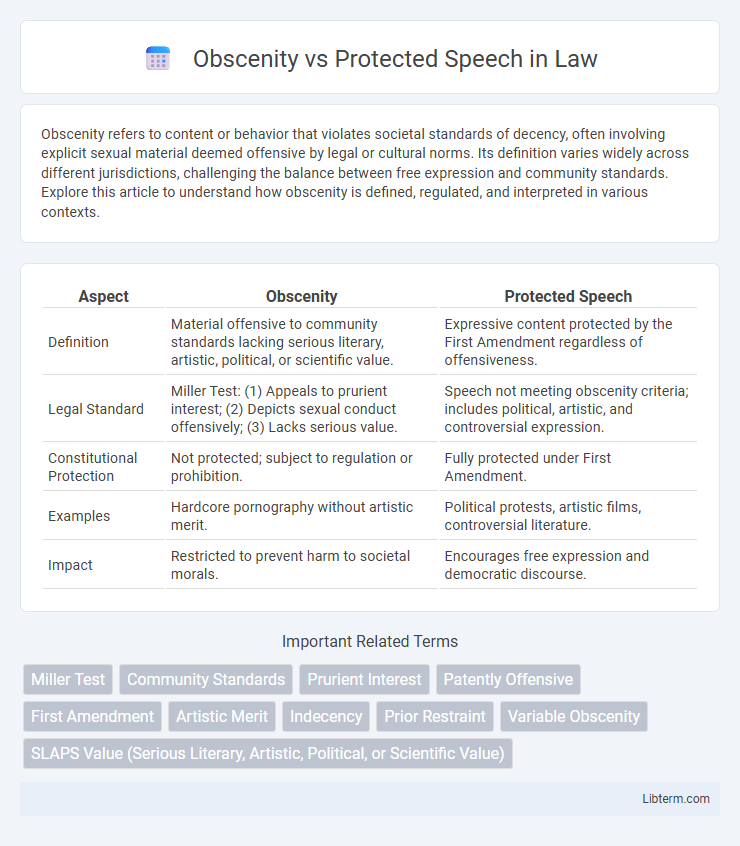Obscenity refers to content or behavior that violates societal standards of decency, often involving explicit sexual material deemed offensive by legal or cultural norms. Its definition varies widely across different jurisdictions, challenging the balance between free expression and community standards. Explore this article to understand how obscenity is defined, regulated, and interpreted in various contexts.
Table of Comparison
| Aspect | Obscenity | Protected Speech |
|---|---|---|
| Definition | Material offensive to community standards lacking serious literary, artistic, political, or scientific value. | Expressive content protected by the First Amendment regardless of offensiveness. |
| Legal Standard | Miller Test: (1) Appeals to prurient interest; (2) Depicts sexual conduct offensively; (3) Lacks serious value. | Speech not meeting obscenity criteria; includes political, artistic, and controversial expression. |
| Constitutional Protection | Not protected; subject to regulation or prohibition. | Fully protected under First Amendment. |
| Examples | Hardcore pornography without artistic merit. | Political protests, artistic films, controversial literature. |
| Impact | Restricted to prevent harm to societal morals. | Encourages free expression and democratic discourse. |
Understanding Obscenity and Protected Speech
Obscenity is defined by the Miller test, which assesses whether the content appeals to prurient interests, depicts sexual conduct in a patently offensive way, and lacks serious literary, artistic, political, or scientific value. Protected speech under the First Amendment excludes obscenity, ensuring that expressive content with social or political significance receives constitutional protection. Understanding the distinction between obscenity and protected speech is crucial for balancing free expression rights against community standards and legal restrictions.
Legal Definitions: Obscenity vs Protected Speech
Obscenity is legally defined by the Miller Test, which assesses whether the material appeals to prurient interest, depicts sexual conduct offensively, and lacks serious literary, artistic, political, or scientific value, thus excluding it from First Amendment protection. Protected speech under the First Amendment includes expression that does not meet these criteria, encompassing political discourse, artistic works, and adult content with recognized social value. Legal distinctions hinge on community standards and judicial interpretation, shaping the boundary between illegal obscenity and lawful expression.
The First Amendment and Its Limits
The First Amendment protects free speech but does not extend to obscene content, which lacks serious literary, artistic, political, or scientific value. The Supreme Court utilizes the Miller test, established in Miller v. California (1973), to determine obscenity by assessing community standards, explicitness, and overall value. Speech deemed obscene falls outside constitutional protection, allowing regulation and restriction without violating First Amendment rights.
Landmark Court Cases on Obscenity
Landmark court cases such as Miller v. California (1973) established the Miller test, which defines obscenity by evaluating whether material appeals to prurient interests, depicts sexual conduct offensively, and lacks serious literary, artistic, political, or scientific value. In Roth v. United States (1957), the Supreme Court ruled that obscenity is not protected by the First Amendment, setting a precedent for restricting certain explicit content. These rulings balance community standards with free speech rights, shaping legal boundaries for obscene material.
The Miller Test: Determining Obscenity
The Miller Test establishes a three-pronged standard for determining obscenity by evaluating whether the average person, applying contemporary community standards, would find the work appeals to prurient interests; whether the work depicts sexual conduct in a patently offensive way as defined by state law; and whether the work lacks serious literary, artistic, political, or scientific value. This U.S. Supreme Court framework balances First Amendment protections against societal interests in regulating obscenity by providing clear criteria for distinguishing protected speech from unprotected obscene material. Application of the Miller Test varies by jurisdiction, reflecting local community standards while safeguarding constitutionally protected expression.
Differences Between Obscene and Protected Expression
Obscenity lacks First Amendment protection because it violates community standards, depicts sexual conduct in a patently offensive way, and lacks serious literary, artistic, political, or scientific value. Protected speech, including offensive or controversial content, does not meet all three criteria of the Miller test established by the Supreme Court. The key difference lies in whether the expression holds significant societal value or merely appeals to prurient interests without redeeming qualities.
Contemporary Issues in Obscenity Law
Contemporary issues in obscenity law revolve around balancing First Amendment protections with evolving community standards and digital content proliferation. Courts grapple with defining obscenity in online platforms, where accessibility to diverse audiences challenges traditional measures like the Miller test. Legal debates intensify over regulating explicit material without infringing on protected speech, reflecting tensions between censorship concerns and moral regulation in the digital age.
Online Content: Obscenity in the Digital Age
Obscenity in the digital age challenges legal boundaries as online content rapidly expands, requiring courts to balance community standards against First Amendment protections. The Miller test remains the primary legal framework to determine obscenity by assessing whether content appeals to prurient interests, depicts sexual conduct in an offensive way, and lacks serious literary, artistic, political, or scientific value. Platforms must navigate these standards while managing user-generated content, ensuring compliance with regulations like Section 230 of the Communications Decency Act that shields providers from liability for third-party posts.
Challenges in Enforcing Obscenity Laws
Enforcing obscenity laws faces significant challenges due to varying community standards and the subjective nature of what constitutes obscenity versus protected speech under the First Amendment. Courts often struggle to balance protecting free expression with regulating content deemed offensive or harmful, resulting in inconsistent rulings and unclear legal boundaries. Technological advancements and digital platforms further complicate enforcement by enabling rapid and widespread distribution of potentially obscene material beyond traditional jurisdictional controls.
Future Trends in Free Speech and Obscenity
Future trends in free speech and obscenity increasingly rely on evolving digital platforms and artificial intelligence to define and regulate content boundaries. Legal frameworks will likely adapt to the complexities of online communication, balancing First Amendment protections with societal norms against harmful obscenity. Emerging technologies and globalized information flows demand nuanced interpretations of protected speech, potentially reshaping obscenity standards in courts worldwide.
Obscenity Infographic

 libterm.com
libterm.com